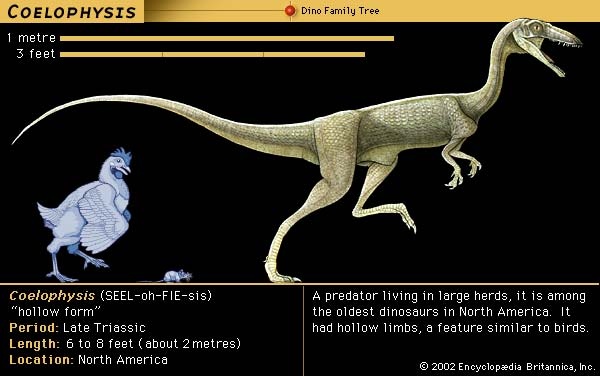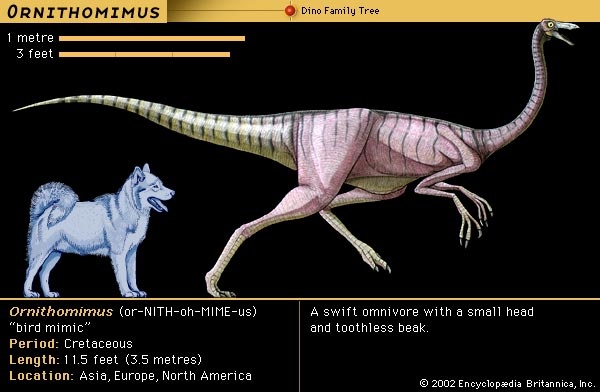theropod
dinosaur suborder
 any member of the dinosaur subgroup, Theropoda, that includes all the flesh-eating dinosaurs. Theropods were the most diverse group of saurischian (“lizard-hipped”) dinosaurs, ranging from the crow-sized Microraptor to the huge Tyrannosaurus rex (tyrannosaur), which weighed six tons or more.
any member of the dinosaur subgroup, Theropoda, that includes all the flesh-eating dinosaurs. Theropods were the most diverse group of saurischian (“lizard-hipped”) dinosaurs, ranging from the crow-sized Microraptor to the huge Tyrannosaurus rex (tyrannosaur), which weighed six tons or more.Unlike the sauropod saurischians, all the theropods were obligate bipeds; that is, their hind legs provided support and locomotion while the short forelimbs and mobile hands were probably adapted for grasping and tearing prey. Despite the group's name, which means “beast (i.e., mammal) foot,” theropod feet usually resembled those of birds. Birds are descended from one lineage of small theropods and therefore are members of Theropoda.
 Three major theropod groups are generally recognized. Ceratosaurs (dinosaur) were the first and ranged in size from the small Coelophysis to Ceratosaurus, which approached Allosaurus in size. Succeeding the early ceratosaurs were the tetanurans, comprising the carnosaurs (carnosaur) (including Allosaurus) and the coelurosaurs (a larger group that includes Tyrannosaurus (tyrannosaur), dromaeosaurs (dromaeosaur), and Ornithomimus, among others). Coelurosaurs and carnosaurs both had many hollow bones and sharp, recurved teeth along the entire length of their jaws.
Three major theropod groups are generally recognized. Ceratosaurs (dinosaur) were the first and ranged in size from the small Coelophysis to Ceratosaurus, which approached Allosaurus in size. Succeeding the early ceratosaurs were the tetanurans, comprising the carnosaurs (carnosaur) (including Allosaurus) and the coelurosaurs (a larger group that includes Tyrannosaurus (tyrannosaur), dromaeosaurs (dromaeosaur), and Ornithomimus, among others). Coelurosaurs and carnosaurs both had many hollow bones and sharp, recurved teeth along the entire length of their jaws. Theropod remains have been recovered from all continents except Antarctica and from the Late Triassic (Triassic Period) through the Late Cretaceous periods (Cretaceous Period) (from 227 million to 65 million years ago).
Theropod remains have been recovered from all continents except Antarctica and from the Late Triassic (Triassic Period) through the Late Cretaceous periods (Cretaceous Period) (from 227 million to 65 million years ago).- Christian d'Oriola
- Christian Dotremont
- Christiane Amanpour
- Christian Ehrenfels, Freiherr (baron) von
- Christiane Nüsslein-Volhard
- Christian, Fletcher
- Christian, Freiherr (baron) von Ehrenfels
- Christian, Freiherr (Baron) von Wolff
- Christian Friedrich, Baron von Stockmar
- Christian Friedrich Daniel Schubart
- Christian Friedrich Schönbein
- Christian Friedrich Stockmar, Baron von
- Christian Front
- Christian fundamentalism
- Christian Fürchtegott Gellert
- Christian Goldbach
- Christian Gottfried Ehrenberg
- Christian Günther Bernstorff, Graf von
- Christian Günther, Graf von Bernstorff
- Christian Haugwitz, Count von
- Christian Hofmann von Hofmannswaldau
- Christian I
- Christian II
- Christian III
- Christianity